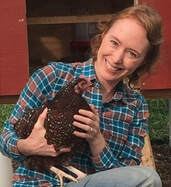
I was planning on doing a homestead update post for you today, but I ran out of time, and so I'm sharing a simple and healthful recipe with you instead. You may be aware of my passion for fermented foods, but long before I ever got started making kimchi, sauerkraut, or various fermented beverages, I was making my own yogurt.
Yogurt is by far one of the easiest fermented foods to make at home: All you need is milk, yogurt culture (or a cup of plain cultured yogurt from the store), and a jar! Of course, you can also get "fancy" and get a yogurt maker like I did (mine was cheap and I've had it for over 10 years and it still works fine), but I started making yogurt in mason jars well before I ever splurged on a real yogurt maker. The process is basically the same, but I will explain both below.
Now that we have a source of local raw milk, I've been making yogurt more regularly than ever, and over the years, I've learned how to make it turn out perfect virtually every time!
I am blessed with a digestive system that doesn't seem to care one way or the other about dairy, and though I'm not a big milk drinker, I do eat yogurt fairly often. It makes a quick and easy light breakfast that I can eat quickly if I'm in a hurry, and it's also good for adding to smoothies, homemade ice cream, and other dishes.
Store bought yogurt is costly and full of sweeteners, thickening agents, preservatives, and other additives, so it just makes sense to make your own - and it's so easy that there's really no excuse not to! Having lots of raw milk on hand also means I'm getting the best quality yogurt - no need to worry about the potential health effects of homogenization or pasteurization.
Here is what you'll need to make your own homemade yogurt from scratch:
- Milk - preferably non-homogenized, low-heat pasteurized, organic, and from grass-fed cows
- Yogurt culture - you can use store bought yogurt (just make sure it's plain yogurt and contains only milk and live active cultures - it should say this on the label - and nothing else), or you can also purchase powdered yogurt culture online (Cultures for Health is a good brand)
- A glass jar (or jars) with a lid (or a yogurt maker)
- A stainless steel saucepan or pot
- A thermometer - a dairy thermometer is best, but any cooking thermometer should be fine as long as it shows low temperatures around 100 degrees F.
Please note that the quality of the milk is very important. Most storebought milk is ultra-pasteurized, which may cause problems with your yogurt setting, so you'll want to look for the low-heat pasteurized kind if you can find it. I have successfully made yogurt in the past with regular storebought whole milk, but it was definitely not as good or as thick as when I use raw or low-heat pasteurized milk.
I typically use either leftover yogurt from a previous batch of homemade yogurt, or storebought plain yogurt as my culture, although I have used powdered cultures in the past and they also worked well. I prefer Greek yogurt as the culture as I find it makes a thicker product, but it does require a bit more stirring, as I have noted below.
Without further ado, here's how to make your own yogurt:
1. Pour milk into a saucepan (I typically use about 5-6 cups as that's what my yogurt maker holds, but you can use more or less depending on your container size; the ratio of milk to culture doesn't have to be super exact). Over medium-low heat, slowly bring the milk up to 175 to 185 degrees F.
2. Keep the temperature at this point for 15-30 minutes, this step is crucial for getting that nice thick yogurt that doesn't need straining.
3. After the 15-30 minutes have passed, cool the milk down to 110 degrees F. If you add the culture before the milk is cooled, you'll kill it. If you add the culture into cold milk, it won't culture. It just likes to be warm, not hot, not cold.
4. Skim off the layer of "skin" on top with a spoon.
5. Pour the warm milk into a clean glass Mason jar. Add starter culture (for this amount of milk, I typically use 4-7 ounces of yogurt, or 1 packet of starter culture powder) and mix in thoroughly. (If using Greek yogurt, add just about 1/2 cup of milk to the jar, whisk or stir in the culture until smooth, then add more milk gradually, whisking until smooth after each addition. This helps prevent lumpy yogurt.)
6. Put a lid on your jar and close it loosely.
7. Keep yogurt at 110 degrees F for 4 to 8 hours. There are a few ways to do this as I mentioned above, and you can also find some other suggestions here.
9. After 4 to 6 hours, check to see if your yogurt is thick. If not, continue culturing for another two hours, then transfer to the refrigerator and store for up to two weeks.
Be sure to save some to culture your next batch! (If you're not making a new batch right away, you can freeze it and just let it thaw completely before using.)
Enjoying Your Homemade Yogurt
Once your yogurt has chilled, it's time to eat! I typically do something quick and easy like a spoonful or two of homemade jam on top, but I also love it with fresh fruit (blueberries or raspberries are my favorite), and a drizzle of real maple syrup. It's also good topped with berries and granola, honey, or savory mix-ins like cucumbers and mint!
You can also use homemade yogurt in various dishes in place of sour cream or buttermilk, as an addition to homemade ice cream (I find it makes it creamier and adds a bit of tang), in homemade dips or dressings, or to give lift to pancakes and other quick breads.
Homemade yogurt is so easy, so delicious, and SO much better for you than the storebought stuff that once you start making it, you'll never go back! Not to mention, it will save you quite a bit of money if you eat a lot of yogurt like I do.
I hope you enjoy this recipe - let me know how it turns out for you!
Rose.
References: https://melissaknorris.com/make-yogurt-home/



 RSS Feed
RSS Feed